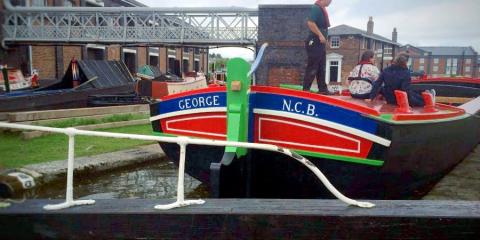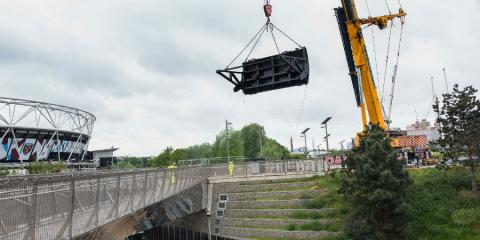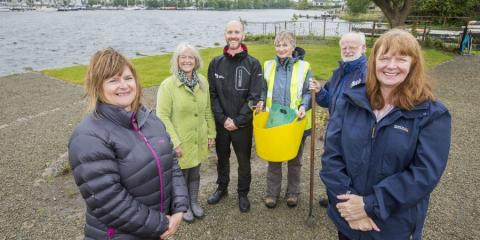More of what C&RT wants you to know
May 2017 - Every now and then we like to keep readers of The Floater up to date with the items being offered to the media by the Canal & River Trust's public relations staff across the country and Peter Underwood has a round up.
George goes back to Liverpool
The Leeds & Liverpool short boat George spent the early 20th century carrying coal from the mines of Wigan and Leigh to Liverpool and she is about to grace the city's docks again.
George’s working life ended in the 1970s but, thanks to volunteers from the National Waterways Museum, Ellesmere Port, she is now restored and refurbished.
She returns to Liverpool Docks this month to give visitors an insight into her story and the history of the local waterways. George will be open in Liverpool’s Salthouse Dock from 12 – 4pm on Tuesday 30 May, Wednesday 31 May and Thursday 1 June.
Visitors will experience a little of what life was like in the cramped conditions on board this hard-working vessel, while activities will transport them back in time with dressing up, model boat making, and arts and crafts sessions.
From June onwards George continues her a new career as a floating education and visitor centre, travelling along the familiar routes of her working life on the Leeds & Liverpool Canal.
The boat will help school groups explore local history, learn about rocks and fossils and discover the geography of the area.
Sam Marine, project assistant explains: "George’s history is interwoven with Liverpool’s story. The coal she carried from Wigan fuelled the city’s factories and power stations, and she was specifically designed to fit through the locks on the Leeds & Liverpool Canal, which give her the title of short boat. We are excited to see her back in the colourful livery of the National Coal Board and cannot wait to share her story with school groups and visitors.”
Big lock is back
A project to restore the historic Carpenters Road Lock in Queen Elizabeth Olympic Park reaches its pivotal stage, with the installation of two giant new lock gates.
The work is being carried out by C&RT, and is one of the final pieces of a ten-year programme to restore the Bow Back Rivers.
The new gates, which weigh over 14 tonnes each – heavier than a London bus – are being carefully swung into position using a 350-tonne crane.
They are the only ‘double radial lock gates’ - two convex-shaped gates swing up vertically to enable boats to pass through - anywhere in the country and will provide the opportunity to navigate from the waterways around the former Olympic Stadium to Waterworks River, which in turn runs south, eventually out to the River Thames.
They will also ensure that the lock plays an important role in flood prevention, with the gates being automated to enable flood water to be distributed to channels within the Bow Back Rivers.
The project is being led by the Trust and includes £680,000 funding from the Heritage Lottery Fund, £100,000 from the London Legacy Development Corporation and £4,500 from the Inland Waterways Association. Work has also included repairing the lock walls and rebuilding the counter balance weights that enable the gates to open.
Carpenters Road Lock was built in the 1930s, however in the second half of the 20thcentury, the Bow Back Rivers fell out of use and the lock became unusable, with the last passage through it by boat recorded in the 1960s. The advent of the London 2012 Games saw major works bringing new life to the waterways in what is now Queen Elizabeth Olympic Park.
Colin Perkins, C&RT project manager, said: "The Bow Back Rivers have been transformed over the last ten years and Carpenters Road Lock is the last piece of the jigsaw, so it’s hugely exciting to be at this crucial point. The lock gates have been built to extremely precise specifications, so it’s only when we swing them into the lock on a crane that we’ll know for sure that they’re a perfect fit. Working around the bridge over the lock also adds to the challenge.
"Carpenters Road Lock is hugely important from both a heritage and engineering point of view. Getting it restored will also create a new route for boaters in this part of London, at a time when boating in the capital is more popular than ever. Subject to how the gate installation goes we’re aiming to have the lock open by the end of August."
To celebrate the restoration, C&RT is planning a range of community events and activities, including an East London Waterway Festival on 28 August, so people can learn about the history of the lock and rivers.
£25,000 tidy up
The Canal & River Trust, which looks after the Lancaster Canal, has worked in partnership with Thurnham Parish Council to completed a £25,000 project that has tidied up an area around the lock entrance to the Lancaster Canal’s Glasson Dock.
Once the largest port in the North West, importing cotton, sugar, spices and slaves from Africa and the Indies, Glasson Dock is now a Scheduled Monument, in the quiet village with a marina and a small, active port.
Thurnham Parish Council successfully secured a £17,280 Landfill Communities Fund grant from the Lancashire Environmental Fund along with contributions from the Canal & River Trust to plant new shrubs, trees and a grassed area to replace overgrown vegetation and broken and uneven paving.
A new bench now offers a viewpoint to enjoy the renewed space and look out onto the Dock and cycle racks have also been installed nearby via Morecambe Bay Partnership.
Nick Smith, Enterprise Manager at the Canal & River Trust, who has been leading on the regeneration project said: “We’ve worked with the local community to improve the main approach into the village, changing an area that had become an eyesore into a much more open and inviting space.
A local boater sees it differently and tells us: “From what I have seen, the bottom gates on the Swingbridge lock were removed for repair, and new walkways installed across the lock.
“The car park is still a mess, and no improvements to any of the visitor moorings.
The Green around the lock has had no major improvements.”
Photos: (1st) Leeds & Liverpool short boat George, (2nd) New gates at Carpenters Road Lock, (3rd) L-R : Christine Milligan, Anne Kingston (LEF), Nick Smith, Christine Rowland, Frank Ford and Maggie Stainton.








